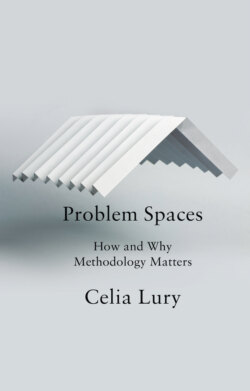Читать книгу Problem Spaces - Celia Lury - Страница 23
Across
ОглавлениеThis chapter has outlined five approaches to methodology, informing vastly different traditions of thought. Each provides an understanding of space that is not that of a fixed container; instead, each provides a way to think about how a problem is happening – is distributed – not in but across many places at a time and in many times at a place.12 The approaches introduced here are thus all of value to the development of the concept of problem space because they provide vocabularies by which to understand the form of problems as emerging in relations of continuity and transformation across a problem space.
Along with their understanding of the importance of relations across rather than in time and space, what also unites these authors – and makes them useful for an understanding of problem spaces – is that they link their understanding of method (if Jullien would allow the term) to more-or-less explicit understandings of potential. And in doing so, their understandings contribute to an understanding of methodological potential as constituted in the operation of limits with-in and out-with problem spaces. The importance of the necessity of the preservation of continuity and connection in a situation becoming a problem while establishing limits for generalization for Dewey, Simon’s insistence on the constitutive possibilities of contingency, the understanding of shi as potential or propensity in a situation described by Jullien, the non-isomorphic possibilities of splitting for the creation of knowledge identified by Haraway, Appadurai’s concern with the inter-relationship of the circulation of forms with forms of circulation all provide resources for a compositional methodology. However, while drawing on and departing from all five approaches, I end this chapter by emphasizing one aspect of Appadurai’s approach.
In the introduction, it was proposed that problem spaces should be seen in terms of the twisting of problems into processes of problematization. More precisely, it was suggested that the compulsion of composition could be understood as the articulation of a double force: the constitutive effects of methods and their capacity to contribute to a problem’s generative circulation. In the chapters that follow, I develop this claim by drawing on Appadurai’s account of the importance of the inter-relationship of the circulation of forms and forms of circulation. This relationship, I propose, is a way to understand the becoming topological of problem spaces to afford methodological potential. The crucial point that Appadurai’s analysis adds to an understanding of the methodological potential of a problem space is that not only do different kinds of problems have different capacities to make use of properties of circulation but also that different forms of circulation have different capacities to support the circulation of problems.
In the chapters that follow, recent changes in the epistemic infrastructure are described, with special attention paid to how such changes configure the compulsion of composition. The argument to be developed is that the properties of these new kinds of circulation are transforming topologies of knowledge, providing new opportunities for methodological invention and these topologies are, in turn (in the torque as it were) transforming forms of problem, shifting relations between knowledge, ignorance and power.
